Phitsanulok
Phitsanulok (Thai: พิษณุโลก, pronounced [pʰít.sā.nú.lôːk] ![]()
Phitsanulok พิษณุโลก | |
|---|---|
| City of Phitsanulok เทศบาลนครพิษณุโลก | |
Phitsanulok skyline from the Grand Riverside Hotel | |
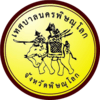 Seal | |
| Nickname(s): Song Khwae (The two rivers) | |
 Phitsanulok Location in Thailand | |
| Coordinates: 16°48′57″N 100°15′49″E | |
| Country | Thailand |
| Province | Phitsanulok |
| District | Mueang Phitsanulok |
| Government | |
| • Type | City Municipality |
| • Mayor | Boonsong Tanthani |
| Area | |
| • City Municipality | 18.26 km2 (7.05 sq mi) |
| • Metro | 751 km2 (290 sq mi) |
| Elevation | 51 m (167 ft) |
| Population | |
| • City Municipality | 68,086 |
| • Density | 3,700/km2 (9,700/sq mi) |
| • Metro | 291,311 |
| • Metro density | 390/km2 (1,000/sq mi) |
| Time zone | UTC+7 (ICT) |
| Postcode | 65000 |
| Area code | (+66) 55 |
| Geocode | 650101 |
| Chief roadway | Route 12 |
| Chief watercourse | Nan River |
| Chief airport | Phitsanulok Airport |
Etymology
- Song Khwae: The first element, song, means the number 'two'. The second element, khwae, means 'tributary', hence 'two rivers'.
- Phitsanulok: The first element, Phitsanu (Thai: พิษณุ; Sanskrit: viṣṇu विष्णु "Vishnu"), is a cognate of 'Vishnu', a Hindu god (see, e.g., Witnu, Thai: วิษณุ). Lack of a v sound in the Thai language accounts for the two forms. The second element, lok (Thai: โลก; Sanskrit: loka लोक 'world') means 'globe' or 'world'. A loose translation of the entire name would be 'Vishnu's heaven'.
Geography
Phitsanulok is in the north of Thailand. Phitsanulok is about 377 kilometres north of Bangkok by road. Phitsanulok covers some 10,815 square kilometres, or 6.4% of area in the north of Thailand and 2.1% of the area of Thailand. Phitsanulok borders on the north and the north-east of Thailand. The north is adjacent to Uttaradit and Laos. The south is adjacent to Phichit. The east is adjacent to Loei and Phetchabun. The west is adjacent to Kamphaeng Phet Province and Sukothai.
Phitsanulok has many waterfalls, forests and caves. In the north is central area. In the north-west is a highland. It's the important recreational area such as Kaeng Sopha waterfall, Phu Hin Rong Kla and Phu Soi Dow. In the south plains along the Yom River and the Nan River is the most important agricultural district of Phitsanulok.
Climate
Phitsanulok has a tropical savanna climate (Köppen climate classification Aw). Winters are dry and very warm. Temperatures rise until April, which is very hot with the average daily maximum at 37.4 °C (99.3 °F). The monsoon season runs from May through October, with heavy rain and somewhat cooler temperatures during the day, although nights remain warm.
| Climate data for Phitsanulok (1981–2010) | |||||||||||||
|---|---|---|---|---|---|---|---|---|---|---|---|---|---|
| Month | Jan | Feb | Mar | Apr | May | Jun | Jul | Aug | Sep | Oct | Nov | Dec | Year |
| Record high °C (°F) | 36.3 (97.3) |
38.4 (101.1) |
40.0 (104.0) |
41.8 (107.2) |
41.5 (106.7) |
39.4 (102.9) |
37.6 (99.7) |
36.7 (98.1) |
35.7 (96.3) |
35.7 (96.3) |
36.4 (97.5) |
35.3 (95.5) |
41.8 (107.2) |
| Average high °C (°F) | 31.6 (88.9) |
33.8 (92.8) |
35.8 (96.4) |
37.2 (99.0) |
35.6 (96.1) |
34.0 (93.2) |
33.2 (91.8) |
32.5 (90.5) |
32.5 (90.5) |
32.4 (90.3) |
31.7 (89.1) |
30.7 (87.3) |
33.4 (92.1) |
| Daily mean °C (°F) | 24.8 (76.6) |
26.9 (80.4) |
29.2 (84.6) |
30.8 (87.4) |
29.9 (85.8) |
29.0 (84.2) |
28.5 (83.3) |
28.1 (82.6) |
28.1 (82.6) |
27.8 (82.0) |
26.5 (79.7) |
24.3 (75.7) |
27.8 (82.0) |
| Average low °C (°F) | 18.7 (65.7) |
21.0 (69.8) |
23.6 (74.5) |
25.4 (77.7) |
25.2 (77.4) |
25.0 (77.0) |
24.8 (76.6) |
24.7 (76.5) |
24.7 (76.5) |
24.1 (75.4) |
21.7 (71.1) |
18.6 (65.5) |
23.1 (73.6) |
| Record low °C (°F) | 10.4 (50.7) |
13.0 (55.4) |
12.7 (54.9) |
19.6 (67.3) |
20.4 (68.7) |
21.0 (69.8) |
21.5 (70.7) |
21.4 (70.5) |
21.7 (71.1) |
17.1 (62.8) |
12.1 (53.8) |
8.9 (48.0) |
8.9 (48.0) |
| Average rainfall mm (inches) | 3.9 (0.15) |
13.5 (0.53) |
26.7 (1.05) |
55.7 (2.19) |
170.9 (6.73) |
165.7 (6.52) |
179.4 (7.06) |
247.6 (9.75) |
246.6 (9.71) |
162.5 (6.40) |
33.4 (1.31) |
11.1 (0.44) |
1,317 (51.85) |
| Average rainy days | 1.3 | 2.2 | 3.3 | 5.6 | 13.7 | 16.2 | 18.1 | 20.4 | 18.7 | 13.3 | 3.5 | 1.0 | 117.3 |
| Average relative humidity (%) | 67 | 64 | 62 | 63 | 71 | 76 | 78 | 80 | 81 | 78 | 72 | 67 | 72 |
| Mean monthly sunshine hours | 257.3 | 243.0 | 275.9 | 243.0 | 198.4 | 117.0 | 120.9 | 117.8 | 108.0 | 179.8 | 219.0 | 257.3 | 2,337.4 |
| Mean daily sunshine hours | 8.3 | 8.6 | 8.9 | 8.1 | 6.4 | 3.9 | 3.9 | 3.8 | 3.6 | 5.8 | 7.3 | 8.3 | 6.6 |
| Source 1: Thai Meteorological Department[2] | |||||||||||||
| Source 2: Office of Water Management and Hydrology, Royal Irrigation Department (sun and humidity)[3] | |||||||||||||
Topography
Phitsanulok lies primarily on flatland with some hills.[4] The eastern portion of the city has some wooded area.[4] The city is in the Nan Basin, which is part of the Chao Phraya watershed.[5] Phitsanulok is sometimes called Song Kwae, the city of two rivers, a name dating to a time centuries ago when the Nan and Khwae Noi Rivers met near the city. Today, only the Nan River flows through Phitsanulok.
History
Khmer Empire
During the 11th century, the city of Phitsanulok was only a small Khmer outpost called Song Khwae, meaning two rivers.[4] At that time, the Nan and Khwae Noi Rivers both flowed through the city, making it a strategic gateway to northern Thailand. The Thais were the majority in the area, however, and would soon establish their independence and form the Kingdom of Sukhothai.
Sukhothai period
- Phitsanulok was the major city in the east of the Sukhothai Kingdom.
- Wat Aranyik and Wat Chedi Yod Thong were constructed.
Ayutthaya period
- Wat Phra Sri Rattana Mahathat was constructed in 1357.
- King Borommatrailokanat moved the capital of the Ayutthaya kingdom to Phitsanulok in 1463 to strengthen the northern boundary of the kingdom.
- Wat Ratchaburana and Wat Nang Phaya were all built during the reign of King Borommatrailokanat.
- King Borommatrailokanat's successor, Boromma Ratchathirat III, returned the capital of the Ayutthaya kingdom to Ayutthaya.
- In 1555, King Naresuan the Great was born in the city.[6]
- Phitsanulok was a major place of recruitment during Ayutthaya's wars with Burma.[6]
- Mother-of-pearl inlaid doors were made in 1756 for the entrance to Wat Phra Sri Rattana Mahathat at the order of King Boromakot.
- After the fall of Ayutthaya to the Burmese in 1767 and the death of its last ruler, a mad monk proclaimed himself king and seized control of Phitsanulok from its royal governor. King Taksin the Great was himself wounded by a musket ball during an unsuccessful attempt to capture the city from the monk. The monk later fled to the north.
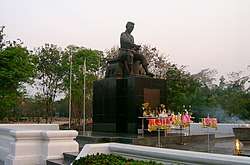
19th century
King Mongkut ordered the restoration of Wat Ratchaburana.
20th century
- The Phitsanulok fire of 1957 destroyed much of the older portion of the city, which at the time consisted mostly of wooden buildings.
- On 28 November 1961, the King Naresuan Shrine was completed at Chandra Palace.
- On 25 January 1967, the Phitsanulok campus of what is now Naresuan University was established as the northern branch of the degree level College of Education. In 1974, the College of Education was upgraded as Srinakharinwirot University, with Phitsanulok as one of the six campuses. In 1990, the regional campuses became independent universities, and the Phitsanuloke campus was named after Phitsanulok-born King Naresuan the Great.
- Naresuan Dam was constructed from 1976 to 1985 on the Nan River as part of the Phitsanulok Irrigation Project.[7] The dam was designed to help prevent flooding of the city.
- On 8 March 1999 Phitsanulok was upgraded to city municipality (thesaban nakhon).[8]
Recent events
- In June, 2001, Phitsanulok hosted the Asia-Pacific Summit of Women Mayors and Councillors.[9]
Government
The chief executive of the city is the mayor.
Royal Thai Army
Phitsanulok is home to the Third Army Region of the Royal Thai Army, responsible for the northern and north-western parts of the kingdom..
Media
The main channels for communication in the city are television and radio. The following public television and radio stations[10] are broadcast from Phitsanulok:
- Sathaanii Witthayu Krajaisiang Thahaan Aakaat (Air Force Radio Station), 954 AM and 95.75, in the City of Phitsanulok
- Witthayu Kong Phon Thahaan Raap Thii Sii (4th Infantry Division), 1377 AM, at Fort Somdet Phra Naresuan Maharat
- Sathaanii Witthayu Phitaksantiraat (Communications Division, Royal Thai Police), 1422 AM, in Phitsanulok City
- ARMY-5 (television channel 5, owned and operated by the Royal Thai Army)[11]
- PRD-11 (television channel 11, owned and operated by the Government Public Relations Department)[11]
Demographics
Ethnic diversity
The majority ethnicity in the city is Thai. Others in the city consider themselves of Mon descent.
Language
The vast majority of residents of Phitsanulok speak central Thai.
Religion
The people of Phitsanulok are predominantly Theravada Buddhists (as are 95% of the Thai population as a whole), with a small Christian community and a few Muslim families.
Infrastructure
Educational Institutions
Naresuan University (abbreviated as Mor Nor for Mahawithayalai Naresuan) is an educational center of the lower northern region of Thailand. Now located in Tha Pho, near the city of Phitsanulok, the university was named after King Naresuan the Great, and the campus features a large statue of him. Other universities and colleges in or around the city include Phitsanulok University (private), Sirindhorn College of Public Health, Rajabhat Pibulsongkram University (formerly a teacher training college), and the Phitsanulok campus of the Rajamangala University of Technology Lanna.
Secondary (Mathayom) Institutions
Phitsanulok is home to one of the top Science and Math Secondary schools in the country. Princess Chulabhorn's College Phitsanulok (PCCPL) is a magnet boarding school that educates 750 students from lower northern Thailand that are looking to have active careers in the STEM fields.
Hospitals
There are several hospitals in the city, both public and private. The province's and the city's primary public hospital is Buddhachinaraj Phitsanulok Hospital and the regional super tertiary care hospital is Naresuan University Hospital at Naresuan University, Tha Pho.
Transportation
Phitsanulok is approximately 75 km from the Unesco World Heritage site at Sukhothai. The city can be reached by both rail and air (Phitsanulok Airport), and is on the intersection of several major highways linking the northern, north-eastern, and central regions of Thailand: Highway 11 (Ta Khli - Chiang Mai), Highway 12 (Mae Sot - Mukdahan) and Highway 117 (Phitsanulok - Nakhon Sawan). Highway 126 is a ring road around the city, allowing through traffic to bypass the city centre.
Culture
Art
Phitsanulok is home to a number of historic sculptures of the Buddha and other religious artwork including the Buddha Chinnarat, the Buddha Chinnasri, the Phra Sri Satsada.
Literature
Examples of important literary works of Phitsanulok include:
- Lilit Yuan Pai (Thai: ลิลิตยวนพ่าย, English: Tale of the Fall of Lanna)
- Lilit Prá Lô (Thai: ลิลิตพระลอ, English: Tale of the Hero Lô)
- Klohng Táwâatsàmàat (Thai: โคลงทวาทศมาส, English: Poem of the Twelve Months)
- Gam Sŏn Sĕe Bpràat (Thai: กำศรวลศรีปราชญ์, English: The Legendary Wise Archer's Grip)
The predominant literary language (as well as the predominant spoken language) is the central Thai dialect of the Thai language, which is written in the Thai alphabet.
Sports
Dragon boat racing has historically been an important element of Phitsanulok culture. In recent times, football (soccer) has become increasingly popular. In 2005, Phitsanulok won the 2nd Northern Youth Football Championship in the U12 and U15 age groups.[12]
Traditional Thai boxing is also a major sport in the city.
Temples
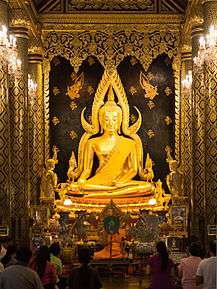
Wat Phra Sri Rattana Mahathat
Phitsanulok's main tourist attraction is Wat Phra Sri Rattana Mahathat, known locally simply as Wat Yai (Thai: วัดใหญ่) (the big temple). This famous temple, built in 1357, is home to the Phra Buddha Chinnarat, which is one of the most revered Buddha figures in Thailand, and the official symbol of Phitsanulok Province. (An exact replica exists in the Marble Temple in Bangkok, and another in Wat Saranat Thammaram in Rayong.) The beautiful mother-of-pearl inlaid doors were built in 1756 by order of King Boromakot of Ayutthaya. The Buddha Chinnarat National Museum, on the temple grounds, houses a sizeable collection of Sukhothai period art. A large provincial fair is held at the temple every January.
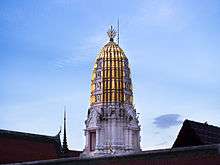
Other temples
The city is home to the following 15 active temples where Theravada Buddhism is practiced by city residents:
- Wat Phra Sri Rattana Mahathat (Thai: วัดพระศรีรัตนมหาธาตุ)
- Wat Ratchaburana (Thai: วัดราชบูรณะ)
- Wat Aranyik (Thai: วัดอรัญญิก)
- Wat Nang Phaya (Thai: วัดนางพญา)
- Wat Chedi Yod Thong
- Wat Tamajak (Thai: วัดธรรมจักร)
- Wat Mai Opayaram (Thai: วัดใหม่อภัยาราม)
- Wat Kuha Sawan (Thai: วัดคูหาสวรรค์)
- Wat Nong Bua (Thai: วัดหนองบัว)
- Wat Sri Wisut Tharam (Thai: วัดศรีวิสุทธาราม)
- Wat Sra Gaew Pratum Thong (Thai: วัดสระแก้วปทุมทอง)
- Wat Tha Maprang (Thai: วัดท่ามะปราง)
- Wat Chan Tawan Tok (Thai: วัดจันทร์ตะวันตก)
- Wat Chan Tawan Ook (Thai: วัดจันทร์ตะวันออก)
- Wat Phan Pi (Thai: วัดพันปี)
Other attractions
- Sergeant-Major Dr. Thawee Buranakhet Folklore Museum: Hosts a collection of folk arts, crafts, basketry, pottery and ancient kitchen utensils.[13] The museum also houses a collection of antique traps for catching snakes, birds, tigers and porcupines.
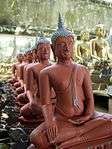
- City walls: Unfortunately, most of the older portions of Phitsanulok were destroyed in a 1955 fire. Thus little else remains of the old town besides the famous temple, an ancient chedi across the road from it, and a small section of the city wall. The intact portion of the ancient city wall is accessible to visitors.[13]
- Buranathai Buddha Foundry: Specializes in casting bronze Buddha images.[14] It is the only establishment of its kind in the province.[14] Craftspersons specialize in the reproduction of the Phra Buddha Chinnarat Buddha image.[14] Visitors are permitted to walk along the production line.[14]
- Nan River Houseboats: Phitsanulok is known throughout Thailand for the houseboats which still line the Nan River near Wat Phra Sri Rattana Maharat, though in recent years these are becoming fewer.[13] A houseboat museum is open to visitors.
- Night Market: Each evening, vendors gather to form Phitsanulok's night market. Items sold include clothing and food, usually at reduced prices.
- Chandra Palace: Chandra Palace was the birthplace of King Naresuan the Great, and contains a shrine to him.
- Naresuan University Art and Culture Gallery: The gallery holds over 100 artistic artworks of culturally significant Thai artists.
Festivals and events
- Phra Buddha Chinnarat Fair: Held each January at Wat Phra Sri Rattana Mahatat Woramahawihan.
- Suan Chom Nan Park Festival: Held twice a year along the Nan River. Food and local products are on sale.
- Dragon Boat Races: On the first weekend of each October, dragon boat races are held outside Wat Phra Sri Rattana Mahatat Woramahawihan in the Nan River. Each dragon boat has a crew of approximately 30 oarsmen.
References
- Thailand, A Short Story, David K. Wyatt, ISBN 0-300-03054-1
- "Climatological Data for the Period 1981–2010". Thai Meteorological Department. p. 5. Retrieved 31 July 2016.
- "ปริมาณการใช้น้ำของพืชอ้างอิงโดยวิธีของ Penman Monteith (Reference Crop Evapotranspiration by Penman Monteith)" (PDF) (in Thai). Office of Water Management and Hydrology, Royal Irrigation Department. p. 32. Retrieved 31 July 2016.
- ThaiTambon.com
- Basins in Thailand Archived 2008-02-22 at the Wayback Machine
- Province page from the Tourist Authority of Thailand Archived 2007-09-30 at the Wayback Machine
- Phitsanulok Irrigation Project Archived 2008-05-03 at the Wayback Machine
- "พระราชกฤษฎีกา จัดตั้งเทศบาลนครพิษณุโลก จังหวัดพิษณุโลก" [Royal Decree Establish of Thesaban Nakhon Phitsanulok Changwat Phitsanulok] (PDF). Royal Thai Government Gazette. 116 (14 Kor): 5–10. 8 March 1999. Retrieved 14 December 2019.
- Asia-Pacific Summit of Women Mayors and Councillors Archived 2007-09-17 at the Wayback Machine
- Radio Stations in Phitsanulok Province, Thailand
- Thai TV: Television Stations in Thailand on VHF and UHF
- Phitsanulok wins the 2nd Northern Youth Football Championship
- Thailand Guidebook-Phitsanulok Province
- Buranathai Buddha Casting Foundry
External links
| Wikimedia Commons has media related to Phitsanulok. |
- Official website


